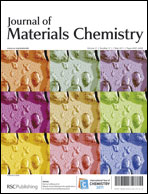The photoelectrochemical (PEC) activity of untreated (not anodized) and anodized nanotubular TiO2 films (synthesized by the electrochemical anodization of Ti foil) was correlated with the phase composition of the film as a function of O2-annealing temperature at 400, 500 and 600 °C. TiO2 nanotubes have been shown to be more efficient than polycrystalline TiO2 for the photocatalytic splitting of water. Raman spectroscopy was used to identify the amorphous and crystalline TiO2 phases as well as the carbon species. The amorphous TiO2 nanotubular array (unheated) exhibits a Raman spectrum consistent with TiO68− octahedra having the same average structure as those present in the anatase and rutile phases of TiO2. Ratios of integrated Raman peaks were used as a semi-quantitative measure of the degree of crystallinity for rutile and the rutile/anatase weight ratio in the films. Results show that the anatase-to-rutile transformation on Ti metal initiates at much lower temperatures compared to polycrystalline TiO2 and this is attributed to oxygen vacancies located at the metal/oxide interface. For untreated films, the amorphous TiO2 crystallizes directly to rutile, and the photocurrent density increases almost linearly with rutile crystallinity as the O2-annealing temperature is increased; anatase does not form on untreated O2-annealed Ti foil. By comparison, amorphous TiO2 nanotubular arrays are converted to about three times as much anatase as rutile at 400 °C, where the photocurrent density is only slightly greater than the corresponding untreated film. At 500 °C, however, the photocurrent density increases to 2.3× that of the untreated-oxidized film, where ∼83% of the TiO2 nanotubular film is rutile and ∼17% is anatase; this enhancement is attributed to the increase in surface area and photoactive sites of the rutile provided by the TiO2 nanotubular array architecture acting as a support. At 600 °C the rutile transformation continues (∼92% rutile), but this is countered by the significant loss of surface area and surface photoactive sites due to degradation and collapse of the nanotubular structure as seen by SEM.

You have access to this article
 Please wait while we load your content...
Something went wrong. Try again?
Please wait while we load your content...
Something went wrong. Try again?


 Please wait while we load your content...
Please wait while we load your content...